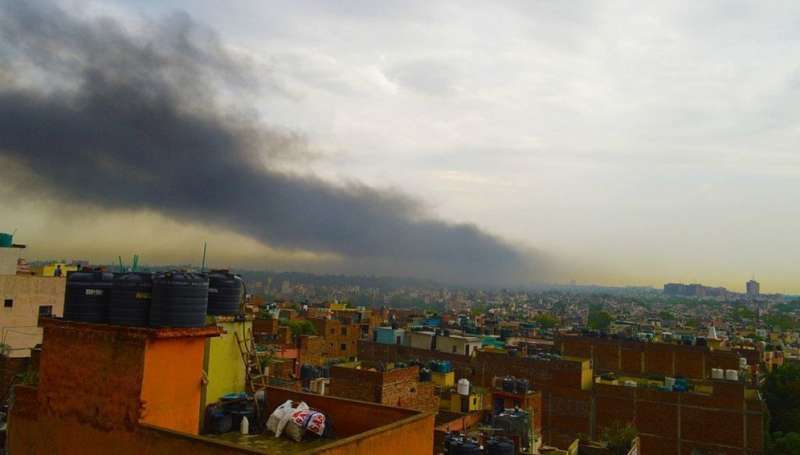Delhi's toxic haze 'fueled by political wrangling'

Ranked as the world's most polluted capital city for four consecutive years, Delhi's dual governance structure involving politically opposed parties has prevented its leaders from agreeing on how to deal with a steadily worsening problem, analysts say.
Home to 32 million people, the National Capital Territory of Delhi is ruled by an elected chief minister who must share power with a lieutenant governor appointed by the central government and has no jurisdiction over important areas like land, police and public order.
With the Bharatiya Janata Party of Prime Minister Narendra Modi in power at the center, constantly at loggerheads with the opposition Aam Aadmi Party led by Chief Minister Arvind Kejriwal, a situation has developed in which each party blames the other for the capital's civic woes, starting with the alarmingly high levels of air pollution.
IQAir, the Swiss air quality technology company, again ranked New Delhi as the world's most polluted capital this year based on measurements of PM2.5 or respirable particulate matter fine enough to enter the bloodstream through the lungs.
Concentrations of PM2.5 over Delhi regularly exceed by more than ten times the WHO standard of five micrograms per cubic meter of air. On 14 November PM 2.5 concentrations were 29.9 times the WHO's annual air quality guideline value.
The Aam Aadmi Party argues that the central government, which makes decisions on environmental issues through the Union Ministry of Environment and Forests and Climate Change, has been progressively relaxing environmental laws in favor of polluting industries.
Reena Gupta, spokesperson for the Aam Aadmi Party and advisor to the Delhi government, says: "The central government's lack of concern for the environment can be seen in the way they have systematically diluted environment laws to allow power plants to come up around Delhi though they are major polluters. It has now become easy for industries to pollute and get away by paying measly fines," she said.
At issue is the policy of the central government to incinerate trash in four waste-to-energy plants. The latest of these plants was inaugurated on 20 October, despite the fact that the three existing ones have been certified as releasing excess PM2.5 and toxic chemicals such as dioxins and furans by the Central Pollution Control Board, India's main regulatory body.
One of the waste-to-energy plants is being allowed to enhance incineration capacity from 2,000 tons per day to 3,000 tons although a committee of experts appointed by the environment ministry did not approve the expansion owing to pollution factors and stiff opposition from residents at public hearings.
"What can be worse than allowing a waste-to-energy plant to expand, after it was certified to be emitting toxic substances like dioxins and furans—no political party is serious about curbing polluting activity within Delhi," says Vinayak Malik, general secretary of the Sukhdev Vihar Residents Welfare Association, which is litigating in the Supreme Court to have the plant shut down or relocated.
Waste-to-energy plants, using crude, mass-burn technology, process more than 6,000 tons of unsegregated waste per day in Delhi and visibly release vast amounts of emissions into the air. They are, however, exempt from the Graded Response Action Plan (GRAP) set in motion on 3 November as the Air Quality Index (AQI) approached the "hazardous" 450 mark.
GRAP, introduced in 2017 under Supreme Court direction, aims to prevent deterioration of air quality once it crosses the 450 AQI threshold in the National Capital Region. Measures include the shutting down of industries burning fuels that are not clean. Municipal solid waste though is considered to be clean fuel and permitted to run to generate electricity.
However, rather than recognizing that industrial activity within the National Capital Region of Delhi is a major contributor to the thick, toxic smog hanging over the city, politicians often lay the blame on farmers who burn agricultural waste in the adjacent states of Punjab, Haryana and Uttar Pradesh at the start of the winter season.
Because Punjab is ruled by the Aam Aadmi Party, the state has, like Delhi, become the focus of intense political wrangling over the pollution issue with the ruling Bharatiya Janata Party. Leaders of both parties accuse each other of negligence.
Central environment minister Bhupender Yadav has accused the Aam Aadmi Party of turning the national capital into a "gas chamber" by allowing farm fires in Punjab to increase by 19% over 2021 levels. Yadav claimed that in Haryana and Uttar Pradesh, states ruled by his Bharatiya Janata Party, there has been a significant reduction in farm fires.
In reaction, Delhi chief minister Kejriwal told media that while pollution is a problem affecting the whole of Northern India, the central government was trying portray Delhi and Punjab as being solely responsible. "It is nothing but politics—the Center is not trying to find real solutions."
Meanwhile, citizens groups and concerned doctors say they are helpless in holding authorities accountable for the alarming rise levels of toxic pollutants in the air over the national capital and the neighboring states this year.
"There is very little actually being done on the ground and we can no longer afford to keep shifting the blame because it is damaging our lungs, heart, brain, kidneys, blood and every organ in the body," says Sanjeev Bagai, a leading city doctor and clean air campaigner.
Bagai believes that without a concerted, collaborative effort by political parties and other stakeholders it is going to be impossible to deal with aerial pollution over Delhi. "We need apolitical decisions right now if we are to save the next generation from disease and disaster."
Provided by SciDev.Net





















